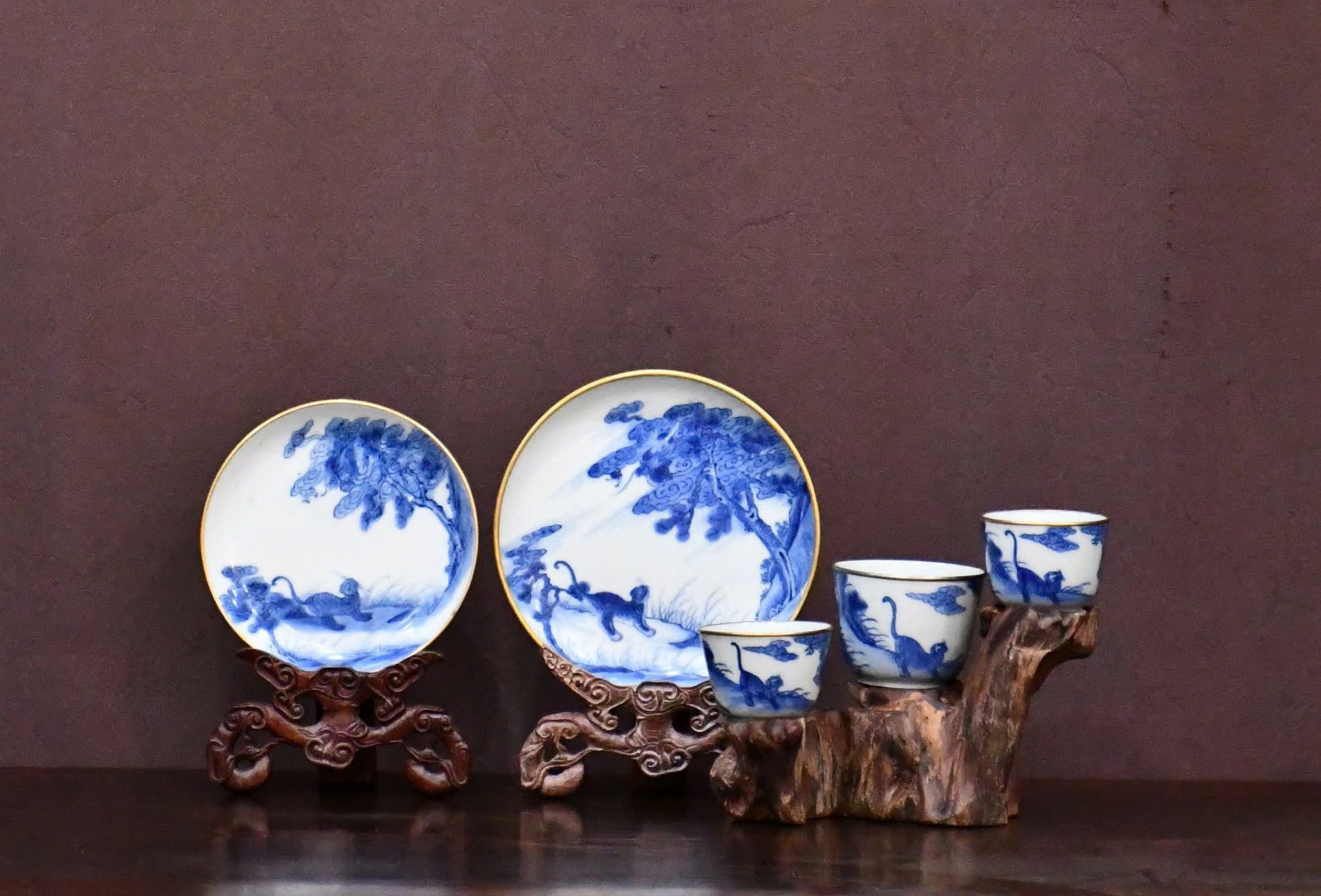Stories under blue glaze
On an early autumn evening, Tam Le's small house on Thanh Thuy Street felt particularly serene. With a warm cup of tea, the scent of incense, and a hundred-year-old wooden bench, the atmosphere seemed just right for our conversation about his passion for antique Vietnamese porcelain, particularly the beautiful blue-glazed pieces from the Nguyen Dynasty.
 |
| Tam Le has carefully curated a tea set decorated with a “Dragon and Tiger Battle” scene, marked "Bich Ngoc" from the 19th century-a collection he’s spent years assembling. Photo: T.Y |
1.Through the director of the Da Nang Museum, Huynh Dinh Quoc Thien, I learned about Tam Le, a discreet figure in Da Nang’s antique collection community. Despite possessing an array of artifacts dating back hundreds of years, his name has rarely appeared in the press. According to the museum director, "Tam Le isn't the kind to boast about his collection, but what he owns is truly impressive." Among his treasures are over 100 pieces of Nguyen-period porcelain, with highlights including various tea sets, bowls, and plates once used by Nguyen royalty in the 18th and 19th centuries.
Holding a porcelain bowl illustrating the Hai Van Mountains alongside a classical Chinese poem titled Ai Linh Xuan Van, composed by Lord Nguyen Phuc Chu (1691-1725) on his journey to the pass, Tam Le explained that this piece represents the Southern Nguyen Lord era. Lord Nguyen Phuc Chu, the eldest son of Lord Nguyen Phuc Thai, succeeded his father in 1691 and was later honored as the National Duke. Porcelain from this time typically featured scenic motifs and poetry, and bore the maker's mark “Thanh Ngoan,” an emblem placed on the base of each piece within a double-circle design.
Though he’s from Da Nang, Tam Le feels a connection to his ancestral roots in Thua Thien Hue. Collecting Vietnamese porcelain has allowed him to not only appreciate the artistry of the past but also to feel closer to history and culture itself. "I admire how ancient artisans poured their soul into each brushstroke, each poem," he reflected as he showed me a bowl painted with a scene of the Thai Binh Temple. Accompanying the scene was a Chinese poem, Tam Thai Thinh Trieu, written by Lord Nguyen Phuc Chu during a visit to Quang Nam in 1719.
"For me, tea is about savouring not only taste but also culture," Tam Le shared as he brought out his “Dragon and Tiger Battle” tea set, marked “Bich Ngoc.” Each piece was used by emperors and nobles, comprising a large communal cup, saucers, and three smaller cups. This set is one of a kind in Viet Nam.
2. Among his many antique pieces, Tam Le finds particular charm in tea sets, which he sees as embodying the elegance and hospitality of the past. During the Nguyen Dynasty, a typical tea set included a large communal cup used to pour tea after letting it settle, several smaller cups, and accompanying saucers. Each piece in the set was similar in design and decoration, differing only in size. He explained that traditional tea ceremonies usually accommodated three guests, hence the three smaller cups in each set. In his collection of nearly 10 Nguyen Dynasty tea sets, Tam Le can discern seasonal designs, such as a "Spring-Autumn Drinking Set" for cooler seasons, distinguished by cups with tall rims and moderately thin porcelain, or the "Summer Set" with wide, shallow cups to help tea cool quickly.
In addition to enjoying tea for its flavor, Tam Le sees tea as a medium through which to engage with history. “Drinking tea from these antique cups is like holding a piece of history,” he said, reminiscing about his discovery of a rare tea set decorated with dragons and tigers. This was an especially prized piece, as he had spent years collecting its individual components. He acquired the saucer with the dragon-and-tiger motif in 2008, followed by two small cups in 2011, and eventually completed the set in 2024 at a “Gathering of Antiques” exhibition in Hue.
Tam Le explained that dragons and tigers symbolize power and resilience in Vietnamese culture, embodying both the strength of nature and the balance of life’s elements. Their coexistence in artistic depictions represents harmony rather than conflict, which he finds especially meaningful.
3. As we looked over his collection, we asked whether he had ever considered displaying it for the public. “Many have suggested it, but these pieces deserve a place where they’re cherished, not just displayed,” he said. “I want visitors to feel the spirit of each item, not merely see them as inanimate objects in a showcase.”
Nguyen-period porcelain often features distinct designs that differentiate Northern and Southern styles, shaped by the cultural influences of the time. Southern Vietnamese porcelain often depicted Central Vietnam’s landscapes and was accompanied by Chinese poems, while the Northern Le-Trinh Dynasty pieces emphasized powerful imagery, such as dragons and phoenixes, reflecting the might of the royal court.
Nguyen Dynasty porcelain is particularly treasured among collectors due to its uniqueness, featuring intricate designs and high-quality blue glaze. Commissioned exclusively for the Vietnamese, all pieces were crafted abroad before being imported back to Viet Nam, adding to their rarity and value.
Reporting by TIEU YEN- Translating by TRUC VY